#AD&D
Text

Krynn and its three moons, Solinari, Lunitari, and Nuitari (George Barr, AD&D supplement Dragonlance Adventures, TSR, 1987)
#D&D#Dungeons & Dragons#George Barr#Dragonlance#Krynn#dnd#AD&D#Dragonlance Adventures#space#moons#planet#1980s#Dungeons and Dragons#TSR
113 notes
·
View notes
Text
yes it is true i have been dungeons and dragons DM for over three decades and still only play second edition. had great time talkin to RASCAL NEWS about the big time campaign i run and my thoughts on what makes a good role playing trot
666 notes
·
View notes
Text
"You shouldn't play Palworld because they blatantly ripped off creature designs from Pokemon!"
Meanwhile the most iconic monster in one of the most important video games of all time and the grandfather of all first-person shooters:

#palworld#video games#FPS#doom#pokemon#gamefreak#dungeons & dragons#astral dreadnaught#wizards of the coast#AD&D#all art is derivative
418 notes
·
View notes
Text
Cold Iron in folklore, fiction, and RPGs
'Gold is for the mistress—silver for the maid!
Copper for the craftsman cunning at his trade.'
'Good!' said the Baron, sitting in his hall,
'But Iron—Cold Iron—is master of them all!'
— Rudyard Kipling, “Cold Iron”
Folklore

Drudenmesser, or "witch-knife", an apotropaic folding knife from Germany
The notion that iron (or steel) can ward against evil spirits, witches, fairies, etc is very widespread in folklore. You hang a horseshoe over your threshold to deny entry to evil spirits, you carry an iron tool with you to make sure devils won't assault you, you place a small knife under the baby's crib to ward it from witches, and so on. Iron is apotropaic in many many cultures.
In English, we often come across passages that refer to apotropaic cold iron (or cold steel). "All uncouth, unknown Wights are terrifyed by nothing earthly so much as by cold Iron", says Robert Kirk in 1691, which I believe is the earliest example. "Evil spirits cannot bear the touch of cold steel. Iron, or preferably steel, in any form is a protection", says John Gregorson Campbell in 1901.
Words
So what is cold iron? In this context, it’s just iron. The “cold” part is poetic, especially – but not only – if we’re talking about either blades (or swords, weapons, the force of arms) or manacles and the like. It just sounds more ominous. There are “cold yron chaines” in The Fairie Queene (1596), and a 1638 book of travels tells us that a Georgian general (in the Caucasus) vowed “to make the Turk to eat cold iron”.
Green’s Dictionary of Slang defines “cold iron” as a sword, and dates the term to 1698. From 1725 it appears in Cant dictionaries (could this sense be thieves’ cant, originally? why not, plenty of words and expressions started as underworld slang and then entered the mainstream), and from ~1750 its use becomes much more common.

NGram Viewer diagram for 1600-2019.
In other contexts, cold iron is (surprise!) iron that’s not hot. So let’s talk a bit about metallurgy.
Metals

In nature, we can find only one kind of iron that’s pure enough to work with: meteoritic iron. It has to literally fall from the sky. Barring that very rare occurrence, people have to mine the earth for iron ore, which is not workable as is. To separate the iron from the ore we have to smelt it, and for that we need heat, in the form of hot charcoals. Throwing the ore on the coals won’t do much of anything, it’s not hot enough. But if we enclose the coals in a little tower built of clay, leaving holes for air flow, the temperature rises enough to smelt the ore. That’s called a bloomery.

clay bloomery / medieval bloomery / beating the bloom to get rid of the slag
What comes out of the bloomery is a bloom: a porous, malleable mass of iron (that we need) and slag (byproducts that we don’t need). But now we can get rid of the slag and turn the porous mass to something solid, by hammering the hot bloom over and over. And once the slag is off, by the same process we can give it a desired shape in the forge, reheating it as needed. This is called “working” the iron, hence “wrought iron” objects, i.e. forged.

a blacksmith in his forge, with bellows, fire, and anvil (English woodcut, 1603)
This is the lowest-tech version, possibly going back to ~2000 BCE in Nigeria. If we add bellows, the improved air flow will raise the temperature. So smelting happens faster and more efficiently in the bloomery, and so does heating the iron in the forge, making it easier to work with. And that’s the standard process from the Iron Age all through the middle ages and beyond (although in China they may have skipped this stage and gone straight to the next one).
If we make the bloomery bigger and bigger, with stronger and stronger bellows, we end up with a blast furnace, a construction so efficient that the temperature outright melts the iron, and it’s liquified enough to be poured into a mould and acquire the desired shape when it cools off. This is “cast iron”.
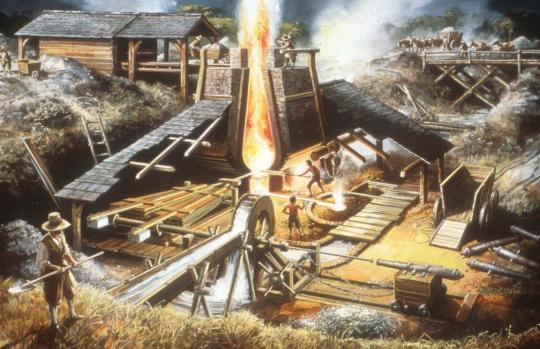
a blast furnace
So in all of this, what’s cold iron? Well, it’s iron that went though the heat and cooled off. (No heat = no iron, all you got is ore.) If it came out of a bloomery, or if it wasn’t cast, it’s by definition worked, hammered, beaten, wrought, and that happened while it was still hot.
Is there such a thing as “cold-wrought” iron? No. In fact, “working cold iron” was a simile for something foolish or pointless. A smith who beats cold iron instead of putting it in the fire shows folly, says a 1694 book on religion, so you too should choose your best tools, piety and good decorum, to educate your children and servants, instead of beating them. When Don Quixote (1605) declares he’ll go knight-erranting again, Sancho Panza tries to dissuade him, but it’s like “preaching in the desert and hammering on cold iron” (a direct translation of martillar en hierro frío).
Minor work can be done on cold iron. A 1710 dictionary of technical terms tells us that a rivetting-hammer is “chiefly used for rivetting or setting straight cold iron, or for crooking of small work; but ’tis seldom used at the forge”. Fully fashioning an object out of cold iron is not a real process – though a 1659 History of the World would claim that in Arabia it’s so hot that “smiths work nails and horseshoes out of cold iron, softened only by the vigorous heat of the sun, and the hard hammering of hands on the anvil”. [I declare myself unqualified to judge the veracity of this statement, let's just say I have doubts.] And there is of course such a thing as “cold wrought-iron”, as in wrought iron after it’s cooled off.
Either way, in the context of pre-20th century English texts which refer to apotropaic “cold iron”, it’s definitely not “cold-wrought”, or meteoritic, or a special alloy of any kind. It’s just iron.
Fiction
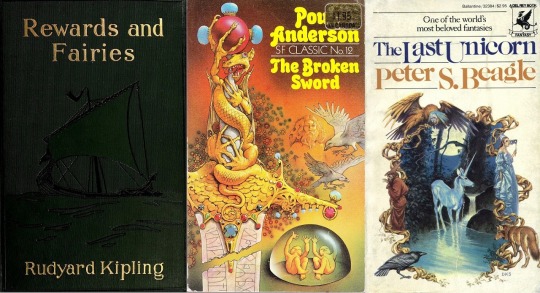
The old superstition kept coming up in fantasy fiction. In 1910 Rudyard Kipling wrote the very influential short story “Cold Iron” (in the collection Rewards and Fairies), where he explains invents the details of the fairies’ aversion to iron. They can’t bewitch a child wearing boots, because the boots have nails in the soles. They can’t pass under a doorway guarded by a horseshoe, but they can slip through the backdoor that people neglected to guard. Mortals live “on the near side of Cold Iron”, because there’s iron in every house, while fairies live “on the far side of Cold Iron”, and want nothing to do with it. And changelings brought up by fairies will go back to the world of mortals as soon they touch cold iron for the first time.
In Poul Anderson’s The Broken Sword (1954), we read:
“Let me tell you, boy, that you humans, weak and short-lived and unwitting, are nonetheless more strong than elves and trolls, aye, than giants and gods. And that you can touch cold iron is only one reason.”
In Peter S. Beagle’s The Last Unicorn (1968) the unicorn is imprisoned in an iron cage:
“She turned and turned in her prison, her body shrinking from the touch of the iron bars all around her. No creature of man’s night loves cold iron, and while the unicorn could endure its presence, the murderous smell of it seemed to turn her bones to sand and her blood to rain.”
Poul Anderson would come back to that idea in Operation Chaos (1971), where the worldbuilding’s premise is that magic and magical creatures have been reintroduced into the modern world, because a scientist “discovered he could degauss the effects of cold iron and release the goetic forces”. And that until then, they had been steadily declining, ever since the Iron Age came along.
There are a million examples, I’m just focusing on those that would have had a more direct influence on roleplaying games. However, I should note that all these say “cold iron” but mean “iron”. Yes, the fey call it cold, but they are a poetic bunch. You can’t expect Robin Goodfellow’s words to be pedestrian, now can you?
RPGs

And from there, fantasy roleplaying systems got the idea that Cold Iron is a special material that fey are vulnerable to. The term had been floating around since the early D&D days, but inconsistently, scattered in random sourcebooks, and not necessarily meaning anything else than iron. In 1st Edition’s Monster Manual (1977) it’s ghasts and quasits who are vulnerable to it, not any fey creature. Devils and/or fiends might dislike iron, powdered cold iron is a component in Magic Circle Against Evil, and “cold-wrought iron” makes a couple of appearances. For example, in AD&D it can strike Fool’s Gold and turn it back to its natural state, revealing the illusion.
Then Changeling: The Dreaming came along and made it a big deal, a fundamental rule, and an anathema to all fae:
Cold iron is the ultimate sign of Banality to changelings. ... Its presence makes changelings ill at ease, and cold iron weapons cause horrible, smoking wounds that rob changelings of Glamour and threaten their very existence.... The best way to think about cold iron is not as a thing, but as a process, a very low-tech process. It must be produced from iron ore over a charcoal fire. The resulting lump of black-gray material can then be forged (hammered) into useful shapes.
— Changeling: The Dreaming (2nd Edition, 1997)
So now that we know how iron works, does that description make sense? Well, if we assume that the iron ore is unceremoniously dumped on coals, it does not. You can’t smelt iron like that. If we assume that a bloomery is involved even though it’s not mentioned, then yes, this is broadly speaking how iron’s been made since the Iron Age, and until blast furnaces came into the picture. But the World of Darkness isn’t a pseudo-medieval setting, it’s modern urban fantasy. So the implication here is that “cold iron” is iron made the old way: you can’t buy it in the store, someone has to replicate ye olde process and do the whole thing by hand. Now, this is NOT how the term “cold iron” has been used in real life or fiction thus far, but hey, fantasy games are allowed to invent things.
Regardless, 3.5 borrowed the idea, and for the first time D&D made this a core rule. Now most fey creatures had damage reduction and took less damage from weapons and natural attacks, unless the weapon was made of Cold Iron:
“This iron, mined deep underground, known for its effectiveness against fey creatures, is forged at a lower temperature to preserve its delicate properties.”
— Player’s Handbook (3.5 Edition, 2003)
Pathfinder kept the rule, though 5e did not. And unlike Changeling, this definition left it somewhat ambiguous if we’re talking about a material with special composition (i.e. not iron) or made with a special process (i.e. iron but). The community was divided, threads were locked over this!
So until someone points me to new evidence, I’ll assume that the invention of cold iron as a special material, distinct from plain iron, should be attributed to TTRPGs.
#long post#cold iron#d&d#Changeling: The Dreaming#World of Darkness#Peter S. Beagle#The Last Unicorn#Rudyard Kipling#Poul Anderson#The Broken Sword#how to rogue#pathfinder#rogues in fiction#Operation Chaos#rogue superstitions#words of the trade#thieves' cant#ad&d#d&d history#1st edition#fey#3.5#fluff#trs
337 notes
·
View notes
Text

Denis Beauvais - Van Richten’s Guide to Vampires, 1991
346 notes
·
View notes
Photo
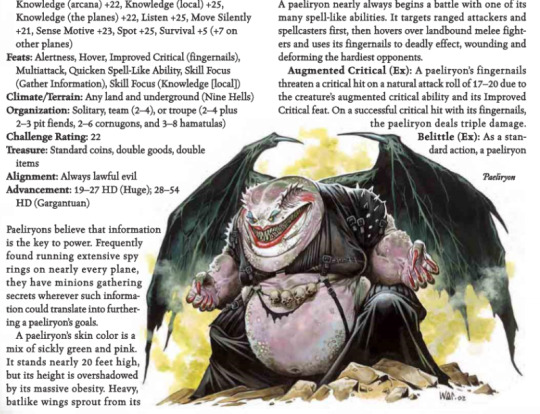

A few days ago I tested out how twitch streaming works by reading the Dungeons and Dragons 3rd Edition Fiend Folio to just a handful of people but when I got to this monster's attacks I couldn’t breathe. Badass fashion sense, yes, kind of sucks that part of the description tried to make it sound scary for having an ambiguous gender, but again this is just otherwise a rad overall look and my god the ATTACKS.
Supernaturally good at insulting you “within a 60 foot cone.” An invisible cone shaped area comes out of this monster, for sixty feet, within which you are so vulnerable to their sick ass burns that this literally stuns you.
This demon can also make you uglier by touching you.
Everyone within 30 feet of this demon also gets drunk automatically.
576 notes
·
View notes
Text
a big peeve of mine specifically with people playing baldur’s gate 3 is when people are like “it’s literally the greatest game ever cuz it literally put d&d in a video game. oh my god no one’s ever done this before” it isn’t called bg3 just because. like they know that baldur’s gate 1 and 2 exist right? like planescape: torment and icewind dale are actual factual games that work off of ad&d like exactly right? like don’t get me wrong i fucking love bg3. i think it’s a masterpiece but like, it isn’t the first game to do this. the other games are so great and i think they deserve some love and appreciation and respect. they don’t deserve to be overshadowed
#d&d#5e#ad&d#bg3#baldurs gate 3#baldur's gate#baldur's gate iii#icewind dale#bg1#bg2#planescape torment#peeves#halfchargedyelw
247 notes
·
View notes
Text

Realms of Horror, illustration by Larry Elmore, 1987
#realms of horror#advanced dungeons & dragons#d&d#ad&d#dnd#dungeons and dragons#advanced dungeons and dragons#tomb of horrors#vintage#fantasy#fantasy art#art#illustration#painting
116 notes
·
View notes
Text
376. Various Authors - Polyhedron #22 (March 1985)

Rounding out March 1985, we get the 22nd issue of the RPGA newsletter which, this month, sports a cover allusive of the Star Frontiers game, the leading SciFi TTRPG published by TSR at the time. Fortunately, for our purposes there is plenty of D&D content inside the cover.

D&D content includes the usual centerpiece module, this time In the Black Hours by David Cook, first used in Gen Con South 1984 and now reprinted here for all those who like their D&D competitive. Gygax contributes some new monsters in an article rectifying some omissions from Monster Manual II and clarifying the Marlgoyle. Gygax shows up again in the official Judge and Players rankings for 1984, being the highest ranking game judge at level 10.
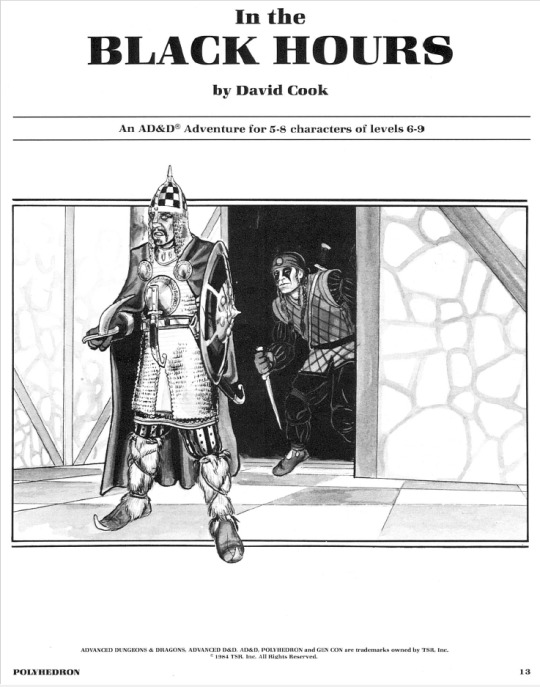
Other articles include some new, but unofficial, Cleric spells and a catalog for ordering some RPGA swag. If you were smart you would have been snagging as many of those R-Series modules as you possibly could for $4.00 and keeping them for a rainy day as each of them would be worth in excess of $1k today. Talk about inflation.
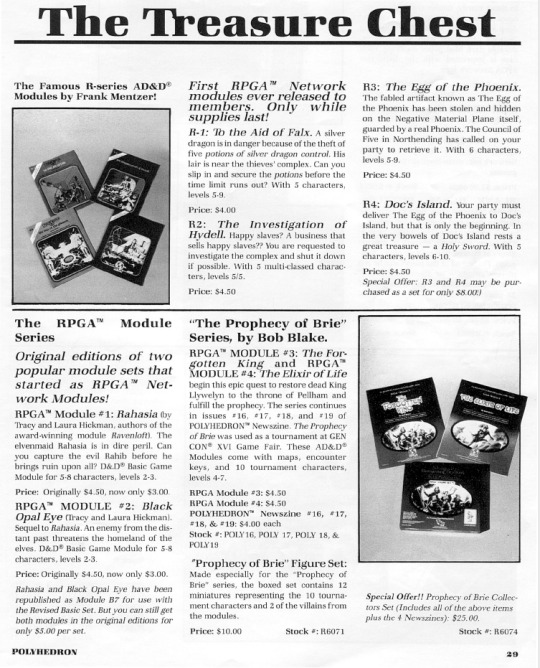
100 notes
·
View notes
Text

Skulltober day 4
Updated my journal.
#inktober2023#inktober#skulltober#fantasy#art#horror#skull#creepy#planescape torment#dungeons and dragons#ad&d
143 notes
·
View notes
Text
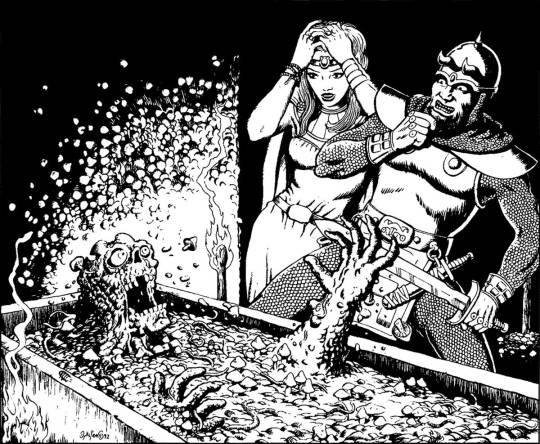
A corpse emerges from the mushroom-covered midden and cries out "You cant make me leave! Never! I'll guard my home forever!" This is a reasonable reaction to being awakened suddenly. (Terry Dykstra, from Steve Kurtz' AD&D Ravenloft adventure "The Price of Revenge," Dungeon magazine 42, July/August 1993)
#D&D#Dungeons & Dragons#Terry Dykstra#Ravenloft#undead#AD&D#Dungeon magazine#dnd#zombie#mushrooms#Steve Kurtz#The Price of Revenge#AD&D 2e#D&D 2e#Dungeons and Dragons
479 notes
·
View notes
Text

Mindflayer
Art by Martin Kepler
162 notes
·
View notes
Text

AD&D - Cormyr Cover Art by Paul Jaquays
#Advanced Dungeons and Dragons#Advanced Dungeons & Dragons#AD&D#Forgotten Realms#Toril#Faerun#Cormyr#Covers#Cover Art#Fantasy#Art#Paul Jaquays#TSR#Wizards of the Coast
72 notes
·
View notes
Text

#mind flayer#illithid#d&d monster#d&d memes#ad&d 1e#ttrpg#d&d#dungeons and dragons#ttrpg memes#old school renaissance#osr#ad&d#ttrpg community#ttrpg art#d&d art#old school d&d#old school d&d art
33 notes
·
View notes
Text
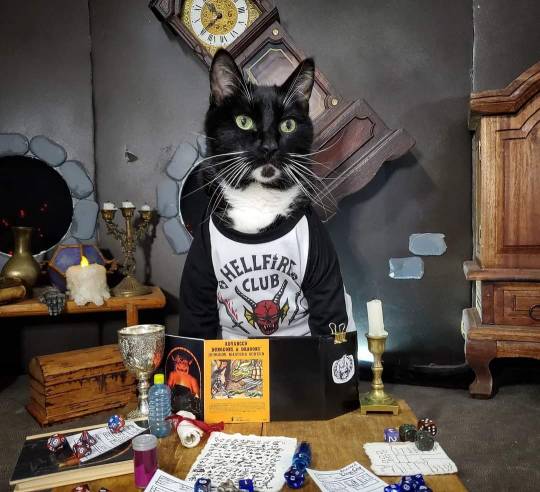
What would be the best D&D Club name for Cats playing?
#dungeons and dragons#club name#cats playing#cat cosplay#cosplay#cats#kitty#cats in costumes#cat#fan art#cat costume#cats of tumblr#aww#strangerthings#stranger things 4#hellfire club#d&d#ad&d#pun names#question#Caturday
1K notes
·
View notes
Photo





I was still too sick to read D&D monsters today but here’s the “official” rust monster designs (printed in licensed D&D books) in order from my least favorite (which is still great) to most favorite (which is just immaculate)
My 2nd favorite wound up being the newest design because of its great little face. I actually prefer when it sticks to looking like something alien rather than just an arthropod, but Tony Diterlizzi’s cricket-like 2E rust monster is adorable and very overlooked.
Above all a good rust monster is a little silly and goofy looking so you know looking at it that it’s not here to hurt you but it IS here to ruin your things
448 notes
·
View notes